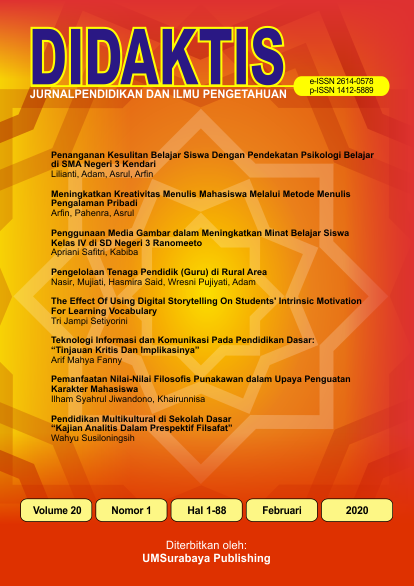The Effect Of Using Digital Storytelling On Students’ Intrinsic Motivation For Learning Vocabulary
Abstrak
Artikel teks lengkap
Referensi
Al-Amri, H. M. (2019). Fostering Intrinsic Motivation and Willingness to Communicate in English as a Foreign Language Classrooms: The Case of Digital Storytelling. Multi-Knowledge Electronic Comprehensive Journal For Education And Science Publications ( MECSJ ), 19, 1–17.
Alismail, H. A. (2015). Integrate Digital Storytelling in Education. Journal of Education and Practice, 6(9), 126–130.
Alizadeh, I. (2016). Vocabulary Teaching Techniques: A Review of Common Practices. International Journal of Research in English Education’, 1(1), 22–30.
Alqahtani, M. (2015). THE IMPORTANCE OF VOCABULARY IN LANGUAGE LEARNING AND HOW TO BE TAUGHT. International Journal of Teaching and Education, 3(3), 21–34. https://doi.org/10.20472/TE.2015.3.3.002
Amelia, L. C. H., & Abidin, M. J. Z. (2018). Young ESL Learners’ Perception on the Effects of Using Digital Storytelling Application in English Language Learning. Pertanika J. Soc. Sci. & Hum, 179–198.
Bai, Z. (2018). An Analysis of English Vocabulary Learning Strategies. Journal of Language Teaching and Research, 9(3), 853–859. http://dx.doi.org/10.17507/jltr.0904.24
Heigham, J., & Croker, R. A. (2009). Qualitative Research in Applied Linguistics A Practical Introduction (first). PALGRAVE MACMILLAN.
Khorasgani, A. T., & Khanehgir, M. (2017). TEACHING NEW VOCABULARY TO IRANIAN YOUNG FL LEARNERS: USING TWO METHODS TOTAL PHYSICAL RESPONSE AND KEYWORD METHOD. International Journal of Languages’ Education and Teaching, 5(1), 90–100. https://doi.org/10.18298/ijlet.1729
Long, C., Ming, Z., & Chen, L. (2013). The Study of Student Motivation on English Learning in Junior Middle School—A Case Study of No.5 Middle School in Gejiu. English Language Teaching, 6(9), 136–145. https://doi.org/10.5539/elt.v6n9p136
Mahadi, T. S. T., & Jafari, S. M. (2012). Motivation, Its Types, and Its Impacts in Language Learning. International Journal of Business and Social Science, 3(24), 230–235.
Ng, C. F., & Ng, P. K. (2015). A Review of Intrinsic and Extrinsic Motivations of ESL Learners. International Journal of Languages, Literature and Linguistics, 1(2), 98–105. https://doi.org/0.7763/IJLLL.2015.V1.20
Panagiotidis, P., Krystalli, P., & Arvanitis, P. (2018). Technology as a Motivational Factor in Foreign Language Learning. European Journal of Education, 1(3), 43–52.
Rehman, A., Bilal, H. A., Sheikh, A., Bibi, N., & Nawaz, A. (2014). The Role of Motivation in Learning English Language for Pakistani Learners. International Journal of Humanities and Social Science, 4(1), 254–258.
Robin, B. R. (2016). The Power of Digital Storytelling to Support Teaching and Learning. Digital Education Review, 30, 17–29.
Smeda, N., Dakich, E., & Sharda, N. (2014). The effectiveness of digital storytelling in the classrooms: A comprehensive study. Smart Learning Environments, 1(6), 1–21. https://doi.org/10.1186/s40561-014-0006-3
Tiba, C., Condy, J., Chigona, A., & Tunjera, N. (2013). Digital storytelling as a tool for teaching: Perceptions of pre-service teachers. TD The Journal for Transdisciplinary Research in Southern Africa, 10(3), 285–301.
Penulis
Hak cipta berada di tangan penulis
Artikel yang terbit dapat digunakan di bawah lisensi Creative Commons Attribution-NonCommercial 4.0 International License.


